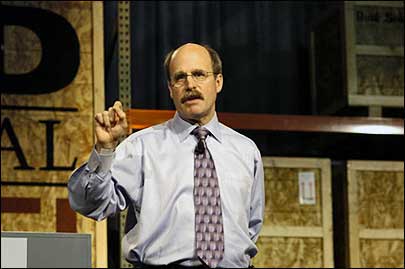RFID has tremendous potential to transform the business world and impact our personal lives—but not as soon or in the ways that we might expect. That’s the message with which Paul Saffo, research director for the Institute for the Future, closed this week’s RFID Journal LIVE! conference in Chicago. He encouraged the crowd of RFID vendors and early adopters to look for opportunities in the businesses and applications that RFID can enable.
Saffo also told attendees that while the benefits that RFID can provide seem close at hand, “most ideas take 20 years to become an overnight success.” He cautioned against giving up on RFID’s potential impact. “Just when people thought MP3 players were dead,” he said, “along came the iPod.

“Your business is just at the point where you could bury yourself in RFID issues and that would be a horrible mistake, because you’ll miss the big opportunities,” Saffo said. “Your business is too small to generate its own lift. The biggest impact on your business is going to come from things utterly outside of it. So pay attention to the things on the outside.”
Saffo advised the crowd to concentrate not only on the technology but also on how it will change our lives. “It’s not about technology,” he said. “You are in the early stages of helping build a real, new kind of media revolution.”
Over the next 10 years, he said, RFID, wireless communications and robotics will each play an important role in what he calls the sensor revolution. Saffo said sensors are creating an early phase of “smartifacts,” or intelligent artifacts, that are “observing the world on our behalf and increasingly manipulating it on our behalf. This is why I view RFID as a media technology. This is where I think the opportunities are for you.”
Saffo said that RFID can take an important cue from Wi-Fi, which changed the Internet in profound ways, not all of which were expected. For example, men, who are notoriously reticent about asking for directions and highly unlikely to print out a map from Mapquest’s Web site before driving somewhere new, can now download a Mapquest page on their Web-enabled PDAs. Similarly, RFID could change the way we use the Internet, or it might play some other, unexpected role in our lives.
Saffo predicts that RFID will let us do old things in new ways. One of the first areas where we might see this is at the consumer level, with applications such as self-checkout; RFID will make the process much easier to use than current ones that use bar codes. And as more items are tagged, he predicts that the physical shape of the modern department store will change. “I think we’re going to see people saying, ‘Hey, we don’t need folks up at the front anymore.’ It’s going to change the whole shape, and feel and size of retail organizations,” Saffo said. “My guess is that in 20 years, stores will not look like stores.”
He also sees an important opportunity for RFID in robotics, because RFID readers and other sensors will allow robotics to operate autonomously. He said robotics, such as the Roomba vacuum cleaner, are already starting to change the way we interact with technology and sensors, and he predicts a significant growth in personal home robotics over the next 10 years.
But Saffo believes that as RFID becomes more ubiquitous, privacy issues are going to become larger and “more weird.” As an example, he mentioned Mexico Attorney General Rafael Macedo de la Concha and 160 of his employees, who have all been implanted with RFID tags in order to gain access to secure areas at the Mexican attorney general’s office. “At the end of the day, we’re going to feel like tagged bears,” Saffo said, “but we’ll find ways to conceal our location.”
Saffo encouraged the innovators and engineers at RFID Journal LIVE! to look at the everyday from a new perspective, to discover the kinds of unexpected applications where he believes the greatest potential for RFID lies. As a source of inspiration, he pointed to the Helios, NASA’s solar-powered, remotely controlled aircraft designed to fly continuously at 80,000 feet and act as an airborne cellular communications tower. “It occurred to [Helios inventor] Paul McCready that a plane that never landed could be useful,” said Saffo. “That’s the kind of thinking that you should do.”

